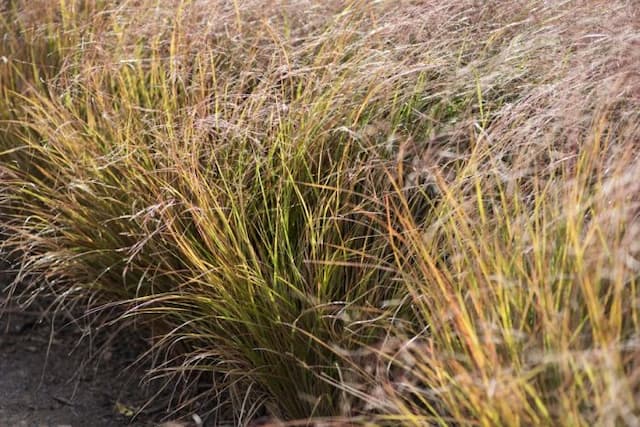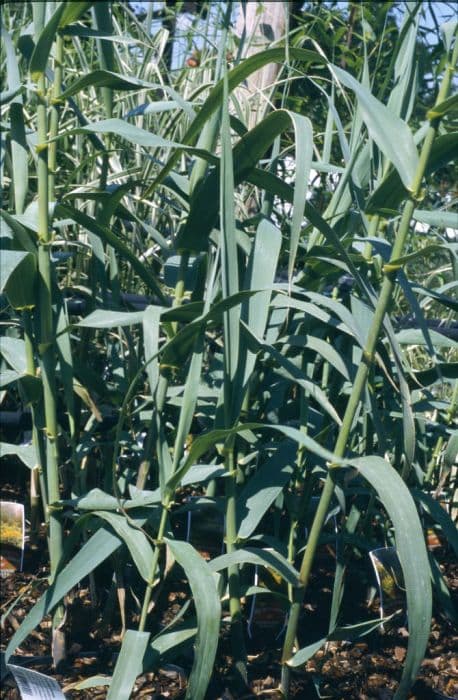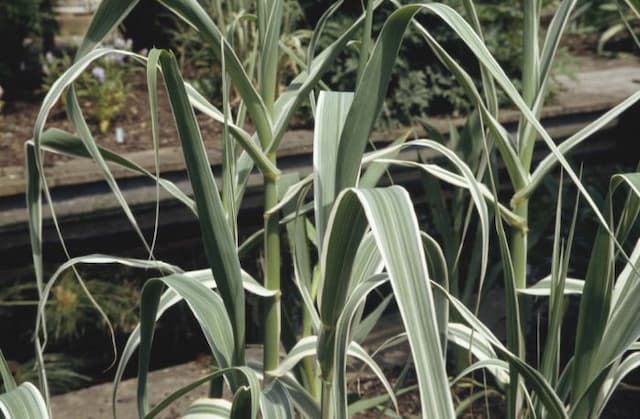Blue Moor Grass Sesleria caerulea

ABOUT
The plant commonly known as blue moor grass is a perennial grass recognized for its compact, mounded clumps of narrow, arching leaves. The foliage presents a unique appearance throughout the year, with its distinct coloration; the leaves are a bluish-green at the base gradually transitioning to a more yellow or straw color at the tips. This two-tone effect provides an attractive contrast in garden settings. During the early to mid-spring, the blue moor grass produces inconspicuous greenish-white flowers, which are later replaced by the seed heads that often take on a purplish to black hue, adding visual interest. These flowers are borne atop stiff, upright flowering stems that rise above the foliage, creating a fine-textured look. The overall form of the plant is neat and tidy, with a dense tufted habit that can add structure to the landscape. While striking, the appearance of the blue moor grass also brings a sense of softness to garden compositions due to its graceful foliage that may gently sway in the breeze. The plant's texture and color make it a versatile choice for various garden themes, blending well with rock gardens, border fronts, or as a ground cover in open areas. Its visual appeal lies not only in its color and form but also in the subtle way it shifts through the seasons, providing year-round interest in appropriate climates.
About this plant
 Names
NamesSynonyms
Blue Moor-grass, Moor Grass, Blue Sesleria
Common names
Sesleria coerulea, Sesleria coerulea f. alba, Sesleria coerulea var. heufleriana, Sesleria coerulea var. pallida, Sesleria coerulea var. virescens, Sesleria oligantha.
 Toxicity
ToxicityTo humans
The plant commonly known as blue moor-grass is not widely recognized for having toxic properties to humans. There are no well-documented symptoms of poisoning because it is not generally considered a hazardous plant to ingest. However, it is always advisable to avoid eating plants that are not commonly recognized as edible, as they may cause digestive discomfort or allergic reactions in some individuals.
To pets
Similar to the information about its effects on humans, blue moor-grass is not known to be toxic to pets. It is not typically associated with causing any specific symptoms of poisoning in animals. Nevertheless, it is still recommended to keep pets from ingesting this or any ornamental plant since individual animals might have sensitivities or allergies that could result in mild gastrointestinal upset.
 Characteristics
CharacteristicsLife cycle
Perennials
Foliage type
Evergreen
Color of leaves
Blue-green
Flower color
Blue
Height
1-2 feet (30-60 cm)
Spread
1-2 feet (30-60 cm)
Plant type
Herb
Hardiness zones
4
Native area
Europe
Benefits
 General Benefits
General Benefits- Ornamental Value: Sesleria caerulea, commonly known as blue moor-grass, is valued for its aesthetic appeal, adding texture and color to garden landscapes.
- Drought Resistance: This plant has good drought tolerance, making it suitable for low-water gardens and xeriscaping.
- Cold Tolerance: Blue moor-grass is resistant to cold temperatures, which makes it versatile for planting in various climates.
- Soil Stabilization: Its root systems can help prevent soil erosion, particularly in sloped areas.
- Low Maintenance: Blue moor-grass requires minimal care once established, needing only occasional watering and no fertilization.
- Wildlife Habitat: It provides shelter for small wildlife and can support local ecosystems.
- Pest Resistance: Sesleria caerulea generally has good resistance to pests and diseases, reducing the need for chemical interventions.
 Medical Properties
Medical PropertiesThis plant is not used for medical purposes.
 Air-purifying Qualities
Air-purifying QualitiesThis plant is not specifically known for air purifying qualities.
 Other Uses
Other Uses- Sesleria caerulea, commonly known as blue moor grass, can be used in eco-friendly roofing materials, particularly green roofs, due to its hardy nature and resistance to drought.
- The grass clumps of blue moor grass are utilized in ornamental garden design for their texture and ability to serve as a year-round ground cover.
- Its dense growth habit can help to prevent soil erosion on slopes and is often used in landscaping projects for this purpose.
- The grass is often incorporated into urban planning for median strips and roadside verges due to its low maintenance requirements and aesthetic appeal.
- Blue moor grass can be used in crafting for decorative purposes, such as making wreaths or dried flower arrangements.
- This grass is useful in xeriscaping, a landscaping technique that reduces or eliminates the need for supplemental water from irrigation.
- Its fibrous roots can be used to stabilize stream banks and prevent the washing away of soils in areas prone to flooding.
- Blue moor grass is occasionally used in educational settings, like biology classes, to teach students about plant adaptation and survival strategies in harsh conditions.
- In wildlife gardens, the plant can provide cover and habitat for small birds and insects.
- The seeds of blue moor grass offer a food source for certain bird species during the winter months when other food options are scarce.
Interesting Facts
 Feng Shui
Feng ShuiThe Blue Moor-grass is not used in Feng Shui practice.
 Zodiac Sign Compitability
Zodiac Sign CompitabilityThe Blue Moor-grass is not used in astrology practice.
 Plant Symbolism
Plant Symbolism- Resilience: Sesleria caerulea, commonly known as Blue Moor Grass, often symbolizes resilience because it thrives in poor soils and can cope with dry conditions once established.
- Tranquility: Its blue-green foliage can evoke a sense of calm and tranquility, making it a symbol for peacefulness in gardens or natural spaces.
- Balance: Blue Moor Grass holds symbolism for balance as it straddles the line between grassy softness and structural form, reflecting the duality of nature's softness and strength.
- Adaptability: This plant adapts to a variety of conditions and can symbolize the ability to adjust and thrive in different environments or situations.
 Water
WaterBlue moor grass should be watered regularly, especially during its first growing season to establish a deep, extensive root system. Once established, it's relatively drought-tolerant and should be watered sparingly, about once a week depending on weather conditions, with deeper, less frequent waterings to encourage root growth. Provide approximately 1 inch of water (about 0.6 gallons) per square foot every week during dry periods. Avoid over-watering as this can lead to root rot.
 Light
LightBlue moor grass thrives best in full sun to partial shade. It prefers a location where it can receive at least six hours of sunlight per day. However, it can also tolerate light shade, especially in areas with very hot summer sun, but its flowering might be reduced in too much shade.
 Temperature
TemperatureBlue moor grass is hardy and can tolerate a wide range of temperatures. It can survive winter temperatures down to -20 degrees Fahrenheit and is suited for gardens in USDA zones 4 to 9. The ideal temperature range for this plant is between 60 and 75 degrees Fahrenheit during the growing season.
 Pruning
PruningPruning blue moor grass is usually done for aesthetic reasons to remove any brown or damaged foliage. Prune in late winter or early spring before new growth starts. Cutting the grass back to about 4 inches from the ground is recommended. Pruning annually will encourage fresh, healthy growth and maintain its tidy appearance.
 Cleaning
CleaningAs needed
 Soil
SoilBlue Moor Grass, or Sesleria caerulea, thrives best in a soil mix that is well-draining, with a slightly acidic to neutral pH range of around 5.5 to 7.0. A blend of garden soil, compost, and sand or gravel would be suitable to facilitate good drainage and mimic its native alpine meadow conditions.
 Repotting
RepottingBlue Moor Grass seldom needs repotting if it is planted outdoors. However, if grown in containers, it may benefit from repotting every 2-3 years to refresh the soil and address overcrowding.
 Humidity & Misting
Humidity & MistingBlue Moor Grass does not have specific humidity requirements, making it versatile and suitable for varied outdoor conditions where humidity levels fluctuate naturally.
 Suitable locations
Suitable locationsIndoor
Place in bright light, avoid overwatering.
Outdoor
Full sun to partial shade; well-draining soil.
Hardiness zone
4-7 USDA
 Life cycle
Life cycleSesleria caerulea, commonly known as blue moor-grass, begins its life cycle when seeds germinate in suitable soil conditions, preferably well-drained and not too fertile, during fall or early spring. The seedlings develop into a dense clump of foliage, consisting of bluish-green leaves that grow in a tufted manner. Over time, usually in early spring, the plant reaches maturity and sends up flowering stems that bear spikelets of blue-green flowers that transition to a soft yellow-brown as they mature. Following flowering, the plant produces seeds by mid-summer, which are dispersed by wind or animals and contribute to the spread of the species. Blue moor-grass is a perennial, so after seed set, the above-ground foliage may die back in late autumn while the root system remains alive; the plant then regrows from its base the following spring. This cycle repeats annually, allowing blue moor-grass to establish long-term populations in grasslands, moors, and rocky outcrops across its native and introduced ranges.
 Propogation
PropogationPropogation time
Spring to Autumn
Propogation: Blue Moor Grass, scientifically known as Sesleria caerulea, can be propagated most effectively through division. This method is best carried out during early spring or autumn. To propagate Blue Moor Grass by division, one should first gently lift the plant from the ground using a garden fork. Care must be taken to keep the root mass intact to avoid stress on the plant. The clump should be divided into smaller sections, ensuring each section has a portion of roots and shoots. These divisions can then be replanted at the same depth they were originally growing, spaced approximately 12 inches (roughly 30 centimeters) apart to allow for adequate room for growth. Watering thoroughly after planting is important to help establish the new divisions.









